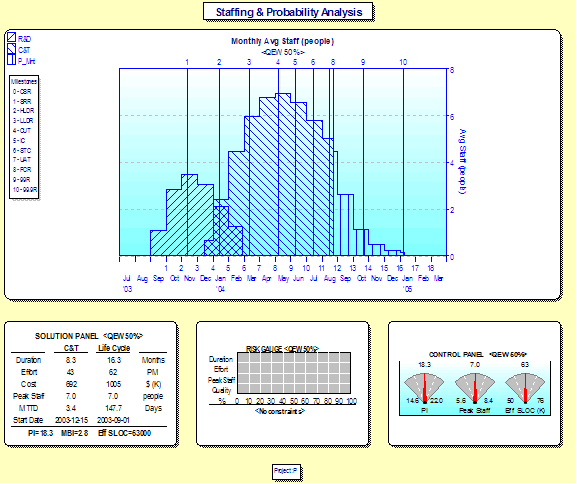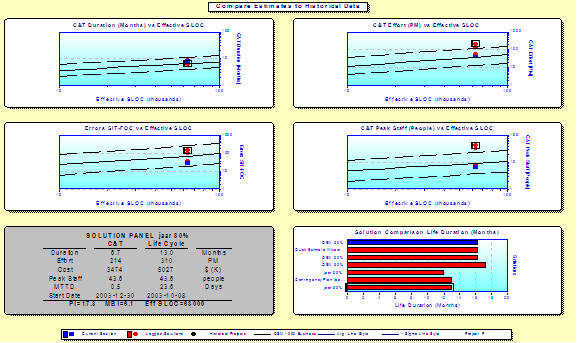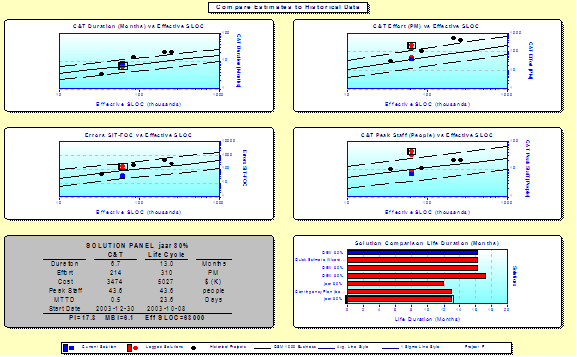|
Predictability
in software development
Ernst
van Waning
QSM
De Corridor 27
3621 ZA Breukelen
the Netherlands
The commercial development of software is not a process that can
be done 'by the eye': the long accepted software crisis is now seen
as a chronic situation facing the IT industry. Developing software
is hard enough but managing software development projects is even
harder to do 'by eye'. Tools are needed to show your development
process as it really is: in project execution, in plans and bids
and in comparison to other projects in the market. Easy to say,
but what does it actually mean?
Software
development projects are like ocean crossings, you don't reach your
goal on gut feelings! Successful crossings are made with instruments
that tell you where you are, where you are going and what weather
you can expect. Managing software development projects is very similar,
without instruments that can tell you what you have achieved and
what you can expect, you are like Christopher Columbus. To his credit,
Columbus did reach the other side of the world but on his first
trip he had no idea how long the journey would take and when he
arrived, never actually knew where he was!
The value of measurement instruments
Further evidence of the importance of measurement instruments can
be found by moving from ocean crossings to everyday traffic on the
roads, as anyone with a speeding ticket will testify.
A speedometer is a device that tells us our speed when driving and
it does this in terms of kilometers or miles per hour. Kilometers
and miles are meaningful terms to us and it is essential that we
talk about speed in a way that everyone can understand. Legal speed
limits are the hard reality of such understanding.
The
beauty of these instruments is that they translate measurements
into meaningful terms. How the instrument does this translation
into speed is only of interest to the designer and not to its user.
In fact we have used speedometers for centuries and the way in which
measurements have been translated has changed over time, but the
concept of what speed is has never changed at all. It's the capability
of these instruments to convey meaningful information to the user
that makes them so useful.
They
make us aware of the situation and enable us to communicate this
information effectively to others. Measurement instruments provide
us with immediate and a meaningful knowledge about the state of
our environment. Knowledge about your own performance and the potential
risks you can take, are expressions of the old proverb 'know thyself'.
Companies that are well informed about their performance tend to
be better at project planning, project bidding and project delivery
than companies with less self-awareness. This knowledge alone will
lead to better customer satisfaction. Possibly the greatest advantage
of this approach is that the knowledge of one's own performance
is the key to systematically improve it!
A dashboard for software development
During a project execution we need to see immediately if we are
on course or on schedule. In the event that we are off schedule,
we need to effectively change course and this requires timely and
accurate information to diagnose the faults and to make the necessary
corrections.
As every project leader will testify during the course of a project,
the world or the perception of the world changes, sometimes even
a combination of both. This normally results in change requests.
Always accepting change requests will quickly damage the project
leader's credibility, but always refusing will inevitably lead to
the same result. A better method is to produce information that
encourages a culture of rational decision-making. For example, an
estimate of the consequences from a change request that is based
on actual project performance will encourage more rational decision-making.
The tool that can do this will use statistical techniques to evaluate
progress. The tool will provide timely warnings that a project may
overrun, estimates of a project's end-date, expected costs, expected
quality at delivery time, all based on actual project data. This
tool would not only inform you about the current status of a project,
but it will also help to determine, (based on actual observations),
how the project may look in future stages of the project lifecycle.
In the diagrams below the black dots represent the observed project
data. The hollow dots are the expectations of how the project will
develop in the future, based on the observed project data.

This tool allows you to manage a project on actual project data.
The data tells you how much time has been spent on what parts of
the projects and how much has been produced in that period of time.
This is often the type of data collected on a simple time sheet.
When this data is entered in a measurement tool, you can quickly
see how your project is performing and where attention is necessary
if the project is underperforming.
Effectiveness
Companies that start to manage their projects by using metrics never
regret the decision. Everyone involved or even interested can quickly
see if a project is performing to company expectations, or if action
is needed to get it back on track. This makes project discussions
more effective, productive and rewarding. Moreover, it will be become
clear very quickly if a project needs corrective action and due
to the quality of the data, any corrective actions are more likely
to produce positive results.
In
turn this means that ongoing project discussions and project negotiations
take up less of the total time, leaving more time for proactive
project management and more focused attention on projects in need.
Apart from spending your time more effectively, you will also be
better informed on the performance of your projects. Companies that
manage their projects in this way report that they have become more
effective, delivering more projects on budget, on time and with
the expected level of quality. By logic, these are the companies
that have a better record of managing their project risks.
Measuring your performance
All companies in some form collect actual project data and this
data tells you exactly how your company is behaving. The tool provides
additional advantages of calculating important parameters like the
performance of your software development projects and the potential
stress that is put on the staff in project delivery.
Better plans, happier customers
As humans we have the remarkable capacity to make rational decisions
in environments that lack any form of accuracy or clarity. We can
give approximate decisions based inaccurate, incomplete and sometimes
rather dubious information. But if this is the case, how has man
been able to progress and develop in what is an ever increasingly
complex world?
Clients expect, if not demand this sort of behavior. They expect
bids before projects start, knowing that correct calculations can
only be made after projects have been finished. Plans and bids are
therefore always uncertain.
Project information
A sudden bright idea has often been the start of a software project.
Discussion follows and comparisons are made about the similarities
with other development projects. These comparisons, however, inaccurate
are the first approximations for a plan.
When other people get interested a somewhat more serious plan is
hurriedly made. As there has been some past experience based on
a similar project, a feasibility study will not be necessary. There
will be Requirements and Design phases and Corrective Maintenance
after the first delivery. The system will probably consist of 80%
business code, 5% telecom code, and 15% system code. Experience
suggests that the system will have 63000 lines of C and there will
be no more than 7 people on the project.
We know very little, if anything about this project, but to see
its consequences in terms of project parameters would be extremely
useful at this early stage. At the very least, an estimate would
give us an idea of the duration and the effort (cost) for such a
project. Duration
and effort are expressed in terms of each other and therefore provide
useful measure by trading off duration v effort. There are other
useful parameters that may not instantly appear at first sight.
For example, do we know our productivity for software development
or the stress we work under when we develop software? If we do not
use metrics or tools as described in the section 'A dashboard for
software development', then we will have no way of knowing these.
In this case, we could fall back on available market data to find
reasonable values to apply to our project.
With any tool the data collection, calculations and metrics are
the all important inputs but equally such a tool must have the capability
to present our findings in clear, unambiguous manner to deliver
the maximum benefit to the decision makers.

The Staffing and Probability Analysis shows the number of people
working on the project during its entire lifecycle, a table with
expected values, a graph showing the probability that certain constraints
will be met (this is not populated as we currently have no constraints)
and pointers (that can be adjusted) indicating productivity, peak
staff and lines of code.
The solution presented above is a likely project scenario. This
means that at a 50% probability we may need more resourcing but
also 50% may need less. In practice, it is advisable to produce
plans with a higher guarantee of delivering what they are planning.
The table below shows the forecast for the entire lifecycle at 50%
and 80% probabilities.
| |
50% |
80% |
|
Description |
| Duration
life cycle |
16.3
|
17.3 |
Months |
R&D,
C&T, 99% error free |
| Effort |
62 |
80 |
PM |
|
| Cost |
1005
|
1291
|
K$ |
|
| Peak
staff |
7
|
8.5
|
People |
|
| MTTD |
147.6
|
121.5
|
days
|
Mean
Time To Defect |
During
the meeting where these numbers are discussed someone states that
this project should take much less time: a year would be more than
sufficient. The same person adds that if we take the maintenance
phase for granted, we would be the first to market.
Ok, how does this affect our project?
| |
50% |
80% |
|
Description |
| Duration
life cycle |
12 |
13 |
Months |
R&D,
C&T |
| Effort |
216 |
310 |
PM |
|
| Cost |
3503 |
5019 |
K$ |
|
| Peak
staff |
33.1 |
43.5 |
People |
|
| MTTD |
31.0 |
23.7 |
days
|
Mean
Time To Defect |
The
results are that the financial cost and the manpower effort are
three to four times higher than in the first plan. The stress on
the project to deliver within one year will be very high and partly
because of this stress the expected quality of the delivery could
be lower. Furthermore, the analysis suggests that a time frame of
13 months is more likely than 12.
Market data
It has been said that a plan without data to calibrate it is pure
speculation. In our case we can compare our plans with relevant
market data.
Below are four graphs and two tables. The graphs plot the lines
of code (LOC) against expected duration, expected effort, peak staff
and the expected number of errors found during construction. The
three lines show market performance, the central line is the average
and the other two show one standard deviation above and below the
average.

Looking at the duration and the expected number of errors, our plan
appears reasonable. In comparison, the plans for a 12-month project
(red circled dot) demand a much higher level of effort and a much
higher peak of staff, compared to the market data.
Company data
Can we trust our plans if we compare them to our own records? The
graphs below demonstrate how our plans compare to projects we have
done previously.

The conclusion remains the same as before in that the peak of staff
for the 12-month project is, when compared to our own records, extraordinarily
high.
A small amount of work can provide a great insight into a project's
feasibility. Estimates of duration and effort are very important
for decisions, but when compared with market data or even better
company data, the confidence will increase that embarking on such
a project is a sound decision.
Benchmarking and performance improvement
Clients of a software development company in the Telecom market
received complaints that they were expensive and their software
contained a high number of errors. To address this, the company
decided to benchmark itself with its peers in the market.
The positive points were the staff's high motivation and technical
know-how, effective company management, a genuine desire by the
staff to contribute to the company and its goals. In contrast a
negative was the amount of pressure applied to deliver projects.
Due to this pressure, there was insufficient time to test code and
no time to document it. The Development Team was completely separate
to the Quality Team. Budgets for education and training were small,
but the time pressure meant that there was no time for education
and training anyway.

The graphs above show trend lines of the company's market. The horizontal
axes show line of code. From left to right the graphs show 'the
number of errors found before delivery', 'the pressure on the project',
'the productivity per staff member', and 'the duration of the functional
design phase'.
Errors found:
Four projects have a high number of errors. The company saw this
as a reason for the client to complain about quality.
MBI (Pressure on projects):
Manpower Buildup Index (MBI). MBI is a measure for the change of
effort per time unit, or the pressure on the project. The company's
projects are all on the high side. Higher MBIs lead to higher project
costs and lower quality.
Productivity per staff member:
In contrast to the market data, the company experiences diminishing
productivity as the projects get larger. This company has complaints
about high prices and low quality. The company spends little time
on documentation and used high staff cost rates. This meant that
the staff could not access the information it needed through documentation
and relied by asking their colleagues. The end result was diminishing
productivity throughout the team and an increasing error rate.
Functional
design:
Analysis shows that the company spent an equal amount of time on
functional design in four of the projects regardless of the size
of those projects
The company introduced a series of improvements. The Development
and Quality teams started to work together, investments were made
in better tooling and plans were based on metrics. Documentation
and its benefits were taken seriously even after the design phase.
Soon the staff became more familiar with the code and the work became
less hectic.
Management realized that project pressure could be lowered and this
resulted in the company achieving lower operating costs and improved
quality for the client.
Conclusion
In today's world, to consider crossing the Atlantic Ocean with only
the instruments and knowledge that Christopher Columbus had available
would be considered both insane and wholly irresponsible. We would
only travel the ocean with every available piece of navigation technology
and communications equipment to safely guide us.
In the centuries after Columbus we have worked out what data to
collect and how to build the instruments that present a journey's
data in the most comprehensible fashion. We know exactly where we
are on the ocean, what kind of weather we can expect and when we
will arrive. Comparable instruments have not only helped us fly
around the world, they have even helped us into space. Good metrics
and instruments made it possible to plan a journey accurately in
advance and to execute that plan with the flexibility to adapt quickly
and effectively to unexpected circumstances. These developments
are closely linked with the progress and development of science.
We have also learned to measure and interpret our measurements in
other areas. Insurance companies translate measurements (counts)
into insurance contracts. Like the development navigation instruments
the development of insurance instruments is work for specialists
(in many cases actuaries). The insurance specialist needs the right
data and then must analyze and interpret the findings in order to
translate the results into a viable product contract.
QSM (www.qsm.com) did the same with software development, by finding
laws and invariants wherever they are present in data regarding
software development. These laws and invariants have found their
place in SLIM Estimate, Control and Metrics.
The cornerstone of the SLIM product suite is that it is based on
a large set of project data and that you collect you own project
data (Control) and use them (Estimate and Metrics). These products
give you an insight into the performance levels in the market and
an objective view of your own performance. When combined these products
allow you to effectively manage the risks involved in software development
projects.
The use of measurement instruments has had an enormous influence
on the development of our society. The use of measurement instruments
for company projects has both a major and a positive impact on the
companies using them. Measurement is the knowledge and as the knowledge
about the work increases there is the beneficial effect that the
staff involvement increases also. The goal of all software development
activity is where the plan works through to completion, the project
delivers to the plan and the company is at all times focused on
delivering the project to meet the 'all important' client expectations.
|